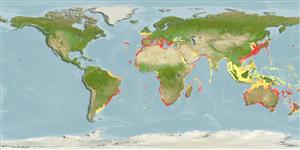Common names from other countries
Environment: milieu / climate zone / depth range / distribution range
বাস্তুসংস্থান
; গভীরতার পরিসীমা 5 - 750 m (Ref. 105665). Tropical; 51°N - 46°S, 68°W - 180°E
Indo-West Pacific, Atlantic Ocean and the Mediterranean.
Length at first maturity / আকৃতি / ওজন / Age
Maturity: Lm ? range ? - ? cm
Minimum depth from Ref. 82060. Bathyal. Inhabits continental shelf and slope (Ref. 2782). It is eurybathic, on coastal detritic bottoms to bathyal muds (Ref. 105665). Uses shells of Bittium latreilli (Ref. 105639). Opportunistic scavenger and predator. Feeds on live crabs, dead shells and fishes (Ref. 106108). Other isotope data (δ15N=9.66±0.25, Ref. 106518).
Life cycle and mating behavior
পরিপক্কতা | প্রজনন | ডিম ছাড়া | ডিমসমূহ | ডিম্বধারন ক্ষমতা | শুককীট
Members of the order Decapoda are mostly gonochoric. Mating behavior: Precopulatory courtship ritual is common (through olfactory and tactile cues); usually indirect sperm transfer.
Markham, J.C. 2003. (Ref. 2782)
IUCN Red List Status (Ref. 130435)
CITES status (Ref. 108899)
Not Evaluated
Not Evaluated
Threat to humans
Harmless
Human uses
| FishSource |
হাতিয়ার
আরো তথ্য
Age/Size
বৃদ্ধি
Length-weight
Length-length
বহিঃ অঙ্গ সংস্থান
শুককীট
প্রাচুর্য
ইন্টারনেট সুত্র
Estimates based on models
Preferred temperature
(Ref.
115969): 9.3 - 20.6, mean 14.8 (based on 532 cells).
